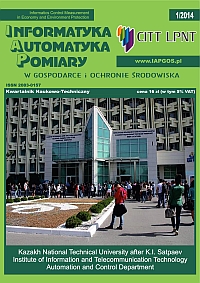IPv6 PROTOCOL - CHARACTERISTICS AND SUGGESTED METHODS OF IMPLEMENTATION IN EXISTING IPv4 NETWORKS USING CISCO ROUTERS
Article Sidebar
Open full text
Issue Vol. 4 No. 1 (2014)
-
OPC TECHNOLOGY AS AN AUTOMATED SYSTEMS INTEGRATION TOOL
Aibek Ashatovich Karatayev, Vasiliy Pavlovich Palshin, Zauresh Mukashevna Yarmuhamedova7-10
-
DEVELOPMENT OF SIMULATION MODEL OF STRIP PULL SELF-REGULATION SYSTEM IN DYNAMIC MODES IN A CONTINUOUS HOT GALVANIZING LINE
Olessya A. Yuchshenko, Waldemar Wójcik11-13
-
OPTIMAL CONTROL SYSTEM OF DIESEL AUTOMOTIVE ENGINEERING BY EXAMPLE OF OPEN PIT MOTOR TRANSPORT
Waldemar Wójcik, Batyrbek Suleimenov, Gennadiy Shadrin, Mikhail Shadrin, Dmitriy Porubov14-17
-
DEFINITION OF THE OBJECTS OF MULTIVARIABLE CONTROL OF TECHNOLOGICAL PROCESS OF SMELTING INDUSTRY ON THE BASIS OF OPTIMIZATION MODEL
Shamil Koshymbaevich Koshymbaev, Zhibek Shegebaeva, Waldemar Wójcik18-20
-
SYNTHESIS OF MANIPULATION ROBOT PROGRAM TRAJECTORIES WITH CONSTRAINTS IN THE FORM OF OBSTACLES
Muhit Baybatshaev, Akambay Beysembaev21-23
-
BUILDING OPTIMAL BOUNDARY CONTROL BY THE SUCCESSIVE APPROXIMATIONS METHOD
Marat Orynbet, Gulmira Bayandina, Gula Tolebayeva24-26
-
CONCEPT OF DEVELOPING AN INTELLIGENT SYSTEM FOR CONTROL AND OPERATIONAL DIAGNOSTICS OF TECHNOLOGICAL EQUIPMENT CONDITION
Batyrbek Suleimenov, Laura Sugurova, Nurbol Turynbetov, Alibek Suleimenov27-32
-
AUTOMATED NMR-RELAXOMETRY FOR CONTROL OF PRODUCTION AND QUALITY
Bekmurza Aitchanov, Anatoli Voronin, Janusz Partyka, Aitkul Aldibekova33-35
-
QUALITY MANAGEMENT SYSTEM IN HEAT SUPPLY OPERATION
Nigina Toktasynova, Gulmira Bazil, Shinar Adilova36-38
-
DETERMINATION OF THE STRUCTURE OF TASKS FOR PHOSPHORIC ORE SMELTING FURNACE CONTROL
Akhmet Ibraev, Perdesh Khairullina39-40
-
CONSTRUCTION METHOD OF OPTIMAL CONTROL SYSTEM OF A GROUP OF UNMANNED AERIAL VEHICLES
Maksym Korobchynskyi, Oleg Mashkov41-43
-
FRACTIONAL MODEL OF FAST PROCESSES IN NUCLEAR REACTOR ANALYSIS
Tomasz Karol Nowak, Kazimierz Duzinkiewicz44-47
-
NUMERICAL ANALYSIS OF ARTIFICIAL HYPERTHERMIA TREATMENT
Łukasz Turchan, Ewa Majchrzak48-53
-
ANALYSIS OF DISTURBANCES IN ELECTRIC POWERS SYSTEMS CAUSED BY LIGHTNING DISCHARGES
Mariusz Benesz, Rafał Tarko54-57
-
IPv6 PROTOCOL - CHARACTERISTICS AND SUGGESTED METHODS OF IMPLEMENTATION IN EXISTING IPv4 NETWORKS USING CISCO ROUTERS
Piotr Kowalik58-61
-
COMPARISON OF PERFORMANCE OF SYNCHRONIZATION ALGORITHMS FOR GRID CONNECTED POWER ELECTRONICS CONVERTERS ACCORDING TO PROPOSED EVALUATION QUALITY CRITERIA
Piotr Lipnicki62-65
-
MEASUREMENT OF THERMAL CONDUCTIVITY COEFFICIENT OF INSULATING LIQUIDS USING AUTHORING MEASUREMENT SYSTEM
Grzegorz Dombek66-68
-
MODELLING OF TRANSIENT HEAT TRANSPORT IN CRYSTALLINE SOLIDS USING THE INTERVAL LATTICE BOLTZMANN METHOD (TWO-DIMENSIONAL MODEL)
Alicja Piasecka-Belkhayat, Anna Korczak69-71
-
LOW POWER PROTOTYPE OF THE INTEGRATED CIRCUIT WITH DUAL-STAGE PULSE PROCESSING FOR TIME AND AMPLITUDE MEASUREMENT
Krzysztof Kasiński, Rafał Kłeczek72-75
Archives
-
Vol. 8 No. 4
2018-12-16 16
-
Vol. 8 No. 3
2018-09-25 16
-
Vol. 8 No. 2
2018-05-30 18
-
Vol. 8 No. 1
2018-02-28 18
-
Vol. 6 No. 4
2016-12-22 16
-
Vol. 6 No. 3
2016-08-08 18
-
Vol. 6 No. 2
2016-05-10 16
-
Vol. 6 No. 1
2016-02-04 16
-
Vol. 5 No. 4
2015-10-28 19
-
Vol. 5 No. 3
2015-09-02 17
-
Vol. 5 No. 2
2015-06-30 15
-
Vol. 5 No. 1
2015-03-31 18
-
Vol. 4 No. 4
2014-12-09 29
-
Vol. 4 No. 3
2014-09-26 22
-
Vol. 4 No. 2
2014-06-18 21
-
Vol. 4 No. 1
2014-03-12 19
-
Vol. 3 No. 4
2013-12-27 20
-
Vol. 3 No. 3
2013-07-24 13
-
Vol. 3 No. 2
2013-05-16 9
-
Vol. 3 No. 1
2013-02-14 11
Main Article Content
DOI
Authors
Abstract
The article constitutes an introduction to IPv6 protocol and is a review of the existing approaches to ensure the coexistence of IPv6 and IPv4, on the example of homogeneous Cisco network infrastructure. In the first paragraph, the IPv6 protocol has been characterized and compared to the IPv4. Then, concepts connected with IPv6 addressing have been described. As the main part, it has been discussed methods to provide the coexistence of the two IP protocols. It has been characterized the primary option which is the dual stack, two types of both point to point and multipoint tunnels and finally - address translation NAT-PT.
Keywords:
References
Dye M., McDonald R., Rufi A.: Network fundamentals, Cisco Press 2008.
Graziani R., Vachon B.: Sieci WAN - zasady dostępu, PWN, Warszawa 2012.
Wendell O.: CCNP Route - Oficjalny przewodnik certyfikacji, PWN, Warszawa 2013.
http://www.cisco.com/en/US/docs/ios-xml/ios/ipv6/configuration/12-4t/ip6-tunnel.html
http://www.cisco.com/en/US/docs/ios-xml/ios/ipv6/configuration/12-4t/ip6-addrg-bsc-con.html
http://www.cisco.com/en/US/docs/ios-xml/ios/interface/configuration/xe-3s/ip6-man-tunls-xe.html
Article Details
Abstract views: 266
License

This work is licensed under a Creative Commons Attribution-ShareAlike 4.0 International License.






